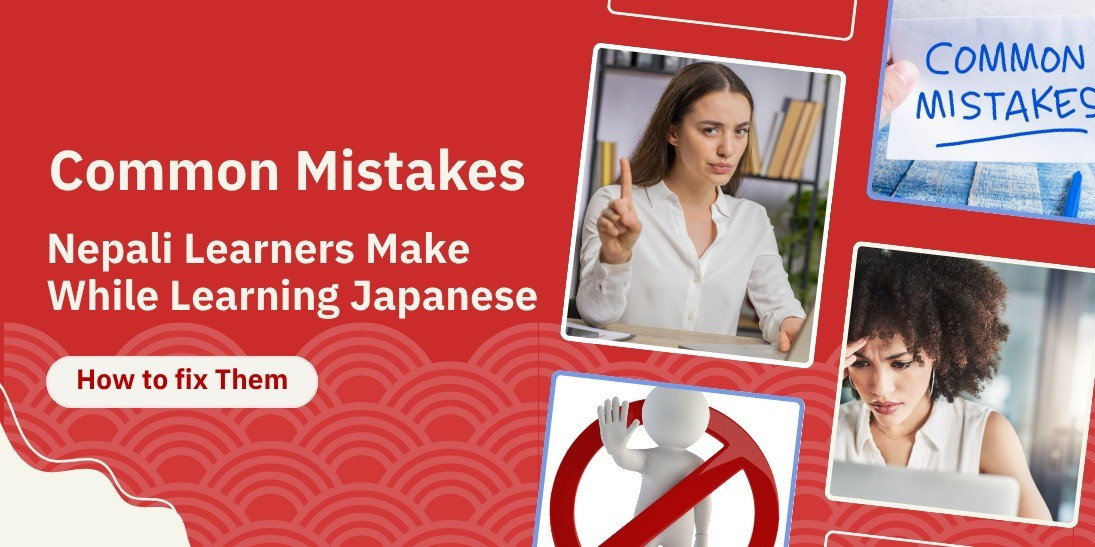
Common Mistakes Nepali Learners Make While Learning Japanese — And How to Fix Them
Learning the Japanese language can be an exciting yet challenging journey, especially for Nepali learners. With its unique scripts, sentence structure, and cultural nuances, Japanese demands both discipline and strategy. However, many learners unknowingly fall into common traps that slow down their progress or lead to confusion.
In this
article, we’ll explore the top mistakes Nepali learners make while learning
Japanese and share practical solutions to help you learn smarter and faster.
Over-reliance
on Romaji (Roman Letters)
Mistake:
Many beginners use Romaji (Japanese written using English alphabets) for too
long and avoid learning Hiragana and Katakana.
Why it’s a
problem: Romaji can be helpful at the start, but it becomes a crutch. It limits
your reading skills and makes it harder to transition to real Japanese texts
and materials.
Solution:
1.
Learn
Hiragana and Katakana in the first 1–2 weeks of study.
2.
Practice
writing them by hand for better memory retention.
3.
Use
flashcards and apps like "Kana Town" or "Dr. Moku".
Memorizing
Vocabulary Without Understanding Context
Mistake: Learners often try to memorize
long vocabulary lists without knowing how or when to use the words.
Why
it’s a problem:
Vocabulary without context is meaningless. For example, learning the word kiku
(聞く) without knowing that it means “to
listen” in some contexts and “to ask” in others can lead to misuse.
Solution:
1.
Learn
words in sentences or with example phrases.
2.
Use
context-based resources like "Tae Kim’s Guide" or the "JLPT
Official Workbook".
3.
Practice
new words in your own sentences or while chatting with native speakers.
Translating
Directly from Nepali or English
Mistake: Many students try to form Japanese
sentences by directly translating from Nepali or English.
Why
it’s a problem:
Japanese grammar is structurally different. For instance, in English we say
"I eat an apple", but in Japanese, it becomes "I apple eat"
(私はリンゴを食べます).
Solution:
1.
Learn
to think in Japanese rather than translating.
2.
Focus
on Japanese sentence patterns (bunkei) like:
3.
「AはBです」(A wa B desu – A is B)
4.
Use
language immersion tools like anime with Japanese subtitles, or easy Japanese
news.
Ignoring
Politeness Levels (Keigo)
Mistake: Beginners often ignore politeness
forms, especially the use of desu/masu and honorific expressions (keigo 敬語).
Why
it’s a problem: In
Japanese culture, politeness is critical. Using informal forms in formal situations
can come off as disrespectful.
Solution:
1.
Learn
basic teineigo (polite form) early on.
2.
Practice
common polite phrases used in daily life like:
3.
お願いします
(onegai shimasu – please)
4.
ありがとうございます
(arigatou gozaimasu – thank you)
Gradually
study keigo when reaching intermediate level, especially if you plan to work or
study in Japan.
Lack of
Speaking and Listening Practice
Mistake: Focusing only on reading and
writing, while avoiding speaking and listening.
Why
it’s a problem:
Language is for communication. If you don’t train your ears and mouth, you’ll
struggle to understand or respond in real conversations.
Solution:
1.
Watch
Japanese YouTube channels, podcasts, or anime with Japanese audio.
2.
Join
online conversation clubs or language exchanges (Tandem, HelloTalk).
3.
Practice
shadowing (repeat after a native speaker with matching intonation).
Final
Advice: Learn
Japanese With a Balanced Approach
Here’s a
simple roadmap for Nepali learners:
✅
Start with Hiragana and Katakana
✅
Learn basic sentence structures, not isolated words
✅
Speak from day one, even if it's just short sentences
✅
Respect politeness levels and cultural etiquette
✅
Surround yourself with Japanese language through media and daily practice
Conclusion
Learning Japanese can be a deeply rewarding journey—opening doors to education, job opportunities, and cultural connection. Avoiding these common mistakes can make your progress smoother and faster. Most importantly, don’t aim for perfection—aim for communication and consistency.


hello hello
hii hii hii hii
hello I am flutter Developer
hello I am mobile Application Developer